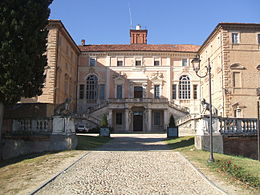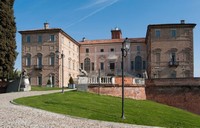
Govone Royal Castle
This post is also available in:
 Italiano (Italian)
Italiano (Italian)
This castle overlooks the town and the valley of the Tanaro River. It was built for defensive purposes before the year 1000, on the highest hill available, then rebuilt in its current appearance from 1600 on by the Solaro Counts: they were partly inspired by architects Guarino Guarini (for the southern façade) and Benedetto Alfieri (for the northern one).
The southern façade is very rich in marble decorations from Venaria, inserted around the middle of the XVIII century by order of the Solaros. With no heirs left, in 1792 the castle and the annexed lands passed to the Royal House of Savoy.
During the French domination, the Savoy family took refuge in Sardinia and the castle, abandoned and stripped of all furnishings, was eventually recovered by the Counts Alfieri di San Martino who bought it and later sold it for a symbolic sum to Carlo Felice di Savoia.
In the 1920s, the Savoy family had the castle restored and the park re-arranged, thanks to architects Giuseppe Cardone and Michele Borda. Govone Castle became the favourite summer residence of Carlo Felice and his wife Maria Cristina di Borbone.
Inside, there are remarkable frescoes in the central hall, “chiaroscuro” paintings by Luigi Vacca and Fabrizio Sevesi, as well as pictorial decorations by Carlo Pagani and Andrea Piazza (with mythological subjects) in the royal apartments.
In 1831, Carlo Felice died without leaving any descendants, thus he was succeeded by Carlo Alberto from the Savoia-Carignano branch of the family; on the death of the widow Maria Cristina in 1849, Govone Castle passed to Ferdinando, the Duke of Genoa, who had the belvedere tower built on the roof.
In 1870, the castle and the land were sold to private investors and in 1897 the local administration bought everything and auctioned some original furniture.
Today, the Royal Castle of Govone is included in the House of Savoy residences that UNESCO (United Nations Organization for Education, Science and Culture) also acknowledged as part of the world artistic heritage (World Heritage) in 1997.
The town hall of Govone is now housed inside the castle which is also used for exhibitions and official events.
The park
The castle is surrounded by an XVIII century Italian garden, with by box hedges and paths leading to the central fountain; there is also an English park, featuring avenues of plane trees and horse chestnuts, as well as an ancient Orangerie (restored by the municipal administration) now used for conferences, meetings and cultural events.
The Italian garden was built at the time of the Solaro counts, in 1700, on the terrace located inside the ancient medieval walls, based on a regular geometric design.
The English park was designed on the northern and western sides in 1800, on behalf of Carlo Felice di Savoia; the architect Xavier Kurten, contracted by the king prince of Carignano, director of the Racconigi park, freely used the vegetation and the actual features of the surrounding landscape to carefully insert fountains, waterfalls, sculptures and various architectural elements. He also built an Egyptian bridge leading to a large English wood, towards the hill of Craviano.
The park was actually built in three different stages: first at the time of Carlo Felice, then after his death in 1833 (at the behest of the widow Maria Cristina), and eventually in 1849 (by Ferdinando, the Duke of Genoa). All the plants, including a rich collection of roses, and the existing vases in the garden and park were carefully catalogued, therefore in 2000, a proper rose garden was created.
This post is also available in:
 Italiano (Italian)
Italiano (Italian)
Contatti
Piazza Vittorio Emanuele 1 - Govone(CN)
0173 58103
turismo@comune.govone.cn.it
http://www.comune.govone.cn.it
Altre info
Visite guidate obbligatorie Intero € 4 - ridotto € 3 (olte 65 anni) - gratuito fino a 14 anni.
Aperto tutte le domeniche da fine marzo a fine ottobre:
Marzo, aprile, maggio, giugno, settembre, ottobre ore 10-12 / 15-18 Luglio e agosto ore 10-12 / 16-19

